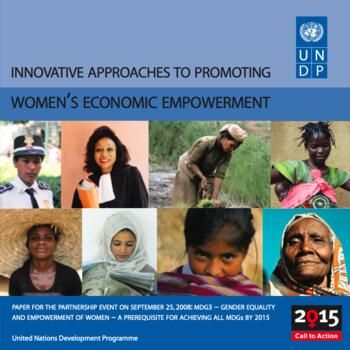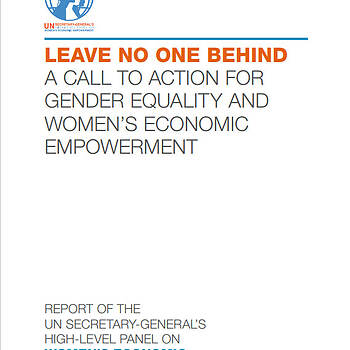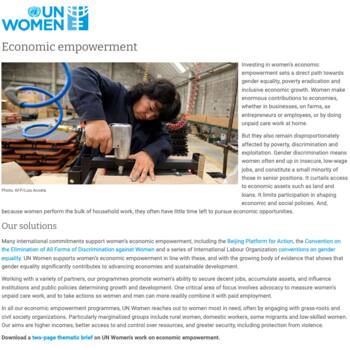What is Women’s Economic Empowerment?
Women’s Economic Empowerment is a process in which women gain access to economic resources and opportunities, and claim space to take economic decisions and act on these decisions. The process is geared to enhancing women’s economic self-reliance and livelihood security. Secondly,
WEE is a strategy to overcome the deeply rooted mechanisms that exclude women from equal opportunities as compared to men. As such, WEE aims to achieve gender transformative change.
And thirdly, WEE is central to realizing women’s rights and gender equality. It is an essential element of gender equality and the empowerment of all women and girls, as formulated in Goal 5 of the Sustainable Development Goals.
What is the current economic status of women as compared to men?
Across the globe, women face inferior income opportunities compared with men. Women are less likely to work for income or actively seek work. The global labor force participation rate for women is just over 50% compared to 80% for men. Women are less likely to work in formal employment and have fewer opportunities for business expansion or career progression. When women have a paid job, they often earn less for comparable work. Emerging evidence from recent household survey data suggests that these gender gaps are heightened due to the COVID-19 pandemic (World Bank gender data portal).
Why are specific approaches to the economic empowerment of women necessary?
As a result of these lower income opportunities, the number of women and girls living in poverty exceeds the number of men and boys. The root causes of this inequality are patriarchy and neoliberal capitalism. Patriarchy keeps women in a subordinate social position with limited bargaining power. It expects women to perform unpaid care tasks and family work. Capitalist market forces tend to exploit or exclude those with little bargaining power. As a consequence, poor women tend to be exploited as cheap labor, or simply excluded from (paid) economic opportunities. If economic development or poverty reduction are left to market forces and/or traditional stereotypes, gender inequalities will only deepen. WEE has been developed as a strategy to break the power dynamics that perpetuate women’s economic marginalization.
What are the benefits of WEE?
WEE’s contribution to realizing women’s rights and gender equality is an important goal in its own right, as a matter of social justice. Additionally, it creates benefits for the entire society.
WEE is usually not a zero-sum game, in the sense that others (men) lose when women gain. On the contrary, in many cases it creates win-win situations in which both the women and other stakeholders are better off. Families benefit, as women tend to spend a greater part of their income on their children’s education and health, thus breaking intergenerational cycles of poverty. Husbands benefit as family incomes increase, often resulting in husbands having greater respect for their wife. Communities benefit as women bring their expertise to collective decision-making. At the same time, since WEE is a process of changing power relations, it may evoke negative reactions and backlash. For instance, incidents of both reduced and increased domestic violence have been reported as a corollary to WEE. The incidence of domestic violence can be reduced by engaging men. As some men said, after their wives’ role in economic production and then household decision-making had increased: “we now have more peace in the household”.
In the economic sector, increased economic participation of women contributes to growth of the gross national product, to the benefit of governments and populations. At the level of private companies, the benefits (and challenges) of gender diversity and inclusion have been proven repeatedly. The potential scale of such benefits has been demonstrated in the reports that McKinsey has been publishing for many years.
A framework for WEE strategies
Over the years it became evident that WEE requires enhancing women’s access, voice and agency in the economic domain. Access refers to the ability to obtain economic resources such as goods, services, markets, finance, technology, networks and opportunities, as means to improve women’s economic position and income. Voice refers to the ability to have a say in decision-making, and agency to the ability to make strategic choices and act upon them.
In 2016, the UN Secretary-General brought together leaders from different constituencies to launch a shared global agenda to accelerate women’s economic empowerment in support of implementing the 2030 Agenda for Sustainable Development. In its first report, this High Level Panel presented a rigorous examination of the case for women’s economic empowerment, its timeliness and the current landscape. The report was complemented by a second report and seven toolkits to support action on the drivers of WEE.
Because of its comprehensive analysis and focus on concrete drivers of WEE, this framework is presented here as a useful background to the issues at stake in WEE.
The framework identified seven primary drivers of WEE:
- Tackling adverse norms and promoting positive role models
- Promoting legal protection and reforming discriminatory laws and regulations
- Recognizing, reducing and redistributing unpaid care and work
- Building assets – digital, financial and property
- Changing business culture and practice
- Improving public sector employment and procurement
- Strengthening women’s collective voice and representation
The four areas of work identified in the framework refer to four types of women’s work:
- Agriculture
- Informal work
- Formal sector employees
- Women-led enterprises
The four areas of work, though overlapping, can be recognized in Dutch development cooperation and its WEE approaches. The classification is used in this timeline, with separate bullets (6-9) for each area of work (see bullet 6, 7, 8, and 9).
As to the drivers of WEE, in Dutch development cooperation explicit attention is visible for building assets (financial, land), changing business culture and practice, and strengthening women’s collective voice and representation. This is reflected in the bullets 10-13 (see bullet 10, 11, 12, and 13). Tackling adverse norms, and promoting legal protection, were addressed in projects that took a comprehensive WEE approach.
The framework highlights that WEE requires change in several sectors, institutions and levels: government, private sector, NGOs and CSOs, communities, families, men and women. This means that WEE strategies require collaboration with ‘unusual partners’ beyond thematic or sectoral networks. For many economic actors in governments and private sector this is a challenge, especially when they are sectorally organised. Moreover, both private sector actors and women’s organisations have their reservations about working together. Overcoming hesitancies, building trust, and organising the relevant stakeholders for WEE multi-stakeholder collaboration is key to WEE.




